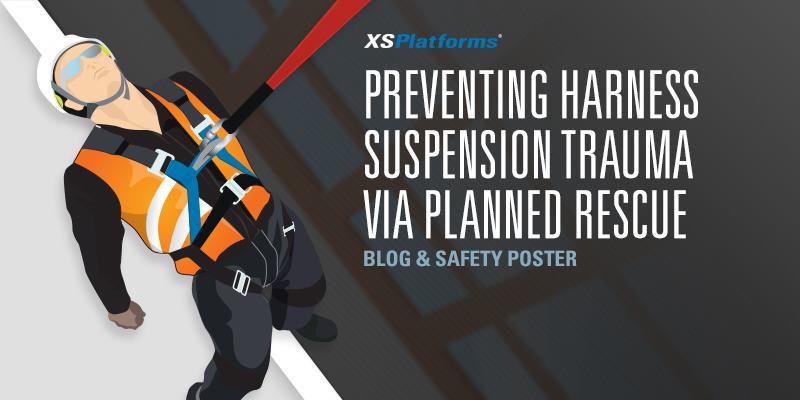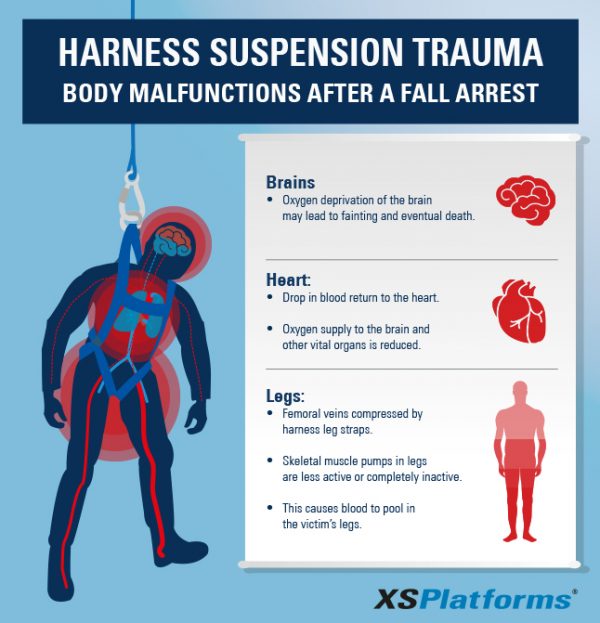
Whenever the risk of a fall is present, both a fall plan and a rescue plan need to be in place. The fall plan details how to prevent falls in the first place, describing fall hazards in the work area, fall protection systems and all the correct procedures and training methods. But as elaborate a fall protection plan is, accidents can always happen. One thoughtless moment and a worker can slip and fall over the edge. Good thing they were wearing a harness and their fall was suspended. But how do you get an employee down after his fall has been suspended? This is why you need a rescue plan.
Rescue swiftly
Just stopping the fall won’t rescue the life of your worker. As discussed in our previous blog about Harness Suspension Trauma (HST) prolonged suspension can cause harm or even be fatal. You have a small time window in which you need to get the worker down. Therefore it is ill advised to wait for emergency responders, as response times may not always be quick enough.
Workers can already experience the first symptoms of HST, such as faintness, after 3 minutes. That is, if they haven’t been knocked unconscious during the fall. The blood circulation of a person is disrupted when suspended in a harness, which results in oxygen deprivation of the brain and heart. You can understand that this can cause serious damage and even be fatal.
Therefore you want to rescue workers as swiftly as possible and get them the medical attention they need.

Have a plan
You need to have a rescue plan in place before employees start working at height. Not only is this a requirement by law in many countries, but a rescue plan also helps prevent stress and chaos. Unplanned rescue attempts can result in more severe injuries and can put the victim and rescuers in harm’s way.
Having a written rescue plan increases the chances of a successful rescue. All site personnel must know the emergency response procedures, so they know who to alert on site for rescue, which emergency services to call and where to find the first aid kit.
An emergency response plan should include:
- The name and contact information of the authorized rescuer(s).
- The best communication method and emergency phone numbers.
- The location and availability of the rescue equipment.
We recommend that you also practice the plan before a real accident happens. This will show your commitment to safety to employees, will help locate weak spots in your rescue plan and gives employees more of an idea what to do in case of a fall.

Make the plan specific
Nobody can predict when or where a fall from height will occur. Therefore a rescue plan must take everything in account. There is no one-size fits all option as each workplace differs. For example, what happens if a worker falls and is suspended while working on a bridge above a river? Or what if a factory worker suspended above moving machinery? Or a worker knocked unconscious on a construction site of a 2-story building? Each situation calls for a different approach, therefore site specific challenges need to be considered when making a rescue plan.
Your rescue plan doesn’t need to be complex or get the size of an old school encyclopedia, but try to ask ‘what if’ questions to ensure you’ve covered all situations. You don’t want to revamp your rescue plan while a rescue is happening. We have a rescue plan checklist made available for your convenience and as a starting point.
Self-rescue
Sometimes workers can rescue themselves and climb back up to the level they’ve fallen from. However, self-rescue or assisted self-rescue is only an option when the worker is conscious. Keep this in mind while making a rescue plan.
Make sure your workers know not to work at height alone. Otherwise there may be a fall no one notices with a disastrous outcome. Even if workers have a phone or radio with them if they are unconscious it won’t do much good.

Rescue equipment
There are products that can lengthen the time before HST sets in, for example leg straps. An employee places their feet in these straps to relieve pressure on the legs and to keep the blood pumping. These straps only work temporarily and when a worker is conscious. However, these straps may give you just a little bit more time to reach an employee.
If it is impossible for a worker to climb back to where he fell from you’ll have to start a rescue procedure. There is equipment available specifically designed for rescue, what equipment fits best depends on the situation and the skills of the rescue personnel. Ensure that rescuers are properly trained. If the rescue is outside of the capabilities of your own team you can see if you can get off-site assistance. Of course this all has to be arranged beforehand.
After the rescue
You’ve managed to get your worker down, depending on how long he/she was suspended make sure that they do not lay down. Keep them sitting up this way the pooled blood will slowly make its way back to the heart, without sending the worker in cardiac arrest.
Begin the accident investigation immediately. Ensure that all the fall arrest equipment used by the worker is replaced. And evaluate the rescue, maybe your rescue plan is up for improvements.
Download a Rescue poster
We have made posters available that show how to act in case of an emergency, The overall rescue process is described on these posters and you can add or fill in important information, like for example who to call in case of a rescue.

2 Comments. Leave new
Por favor mantengan la información actualizada para el tratamiento tras el rescate, lean este articulo y en los demás que se apoya.
http://www.jems.com/articles/print/volume-40/issue-6/features/redefining-the-diagnosis-and-treatment-of-suspension-trauma.html
This is a very important subject.
Good Job.
Jim Barr